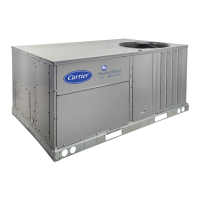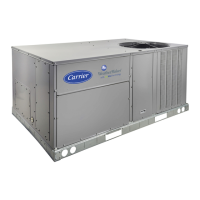39
Table 37 — Cool/Heat Setpoint Offsets Configuration
Operating modes are under Operating Modes
MODE.
Cool Mode Evaluation Logic
The first thing the control determines is whether the unit is in
the occupied mode (OCC) or is in the temperature compensat-
ed start mode (T.C.ST). If the unit is occupied or in tempera-
ture compensated start mode, the occupied cooling setpoint
(OCSP) is used. For all other modes, the unoccupied cooling
setpoint (UCSP) is used. For further discussion and simplifica-
tion this will be referred to as the “cooling setpoint.” See
Fig. 7.
Demand Level Low Cool On Offset (L.C.ON)
This is the cooling setpoint offset added to the cooling setpoint
at which point a Low Cool mode starts.
Demand Level High Cool On Offset (H.C.ON)
This is the cooling setpoint offset added to the “cooling set-
point plus L.C.ON” at which point a High Cool mode begins.
Demand Level Low Cool Off Offset (L.C.OF)
This is the cooling setpoint offset subtracted from “cooling set-
point plus L.C.ON” at which point a Low Cool mode ends.
NOTE: The “high cool end” trip point uses the “low cool off”
(L.C.OF) offset divided by 2.
To enter into a LOW COOL mode, the controlling temperature
must rise above the cooling setpoint plus L.C.ON.
To enter into a HIGH COOL mode, the controlling temperature
must rise above the cooling setpoint plus L.C.ON plus H.C.ON.
To exit out of a LOW COOL mode, the controlling temperature
must fall below the cooling setpoint plus L.C.ON minus L.C.OF.
To exit out of a HIGH COOL mode, the controlling tempera-
ture must fall below the cooling setpoint plus L.C.ON minus
L.C.OF/2.
Comfort Trending
In addition to the setpoints and offsets which determine the trip
points for bringing on and off cool modes, there are 2 configu-
rations which work to hold off the transitioning from a low
cool to a high cool mode if the space is cooling down quickly
enough. This method is referred to as Comfort Trending. The
comfort trending configurations are C.T.LV and C.T.TM.
Cool Trend Demand Level (C.T.LV)
This is the change in demand that must occur within the time peri-
od specified by C.T.TM in order to hold off a HIGH COOL mode
regardless of demand. This is not applicable to VAV control types
(C.TYP = 1 and 2) in the occupied period. As long as a LOW
COOL mode is making progress in cooling the space, the control
will hold off on the HIGH COOL mode. This is especially true for
the space sensor machine control types (C.TYP = 5 and 6), be-
cause they may transition into the occupied mode and see an im-
mediate large cooling demand when the setpoints change.
Cool Trend Time (C.T.TM)
This is the time period upon which the cool trend demand level
(C.T.LV) operates and may hold off staging or a HIGH COOL
mode. This is not applicable to VAV control types (C.TYP = 1
and 2) in the occupied period. See the Cool Trend Demand
Level section for more details.
Timeguards
In addition to the setpoints and offsets which determine the trip
points for bringing on and off cool modes there is a timeguard
of 8 minutes which enforces a time delay between the transi-
tioning from a low cool to a high cool mode. There is a
timeguard of 5 minutes which enforces a time delay between
the transitioning from a heat mode to a cool mode.
Supply Air Setpoint Control
Once the control has determined that a cooling mode is in effect,
the cooling control point (Run Status
VIEW
CL.C.P) is cal-
culated and is based upon either Setpoints
SA.HI or Setpoints
SA.LO, depending on whether a high or a low cooling mode is
in effect, respectively. In addition, if supply air reset is configured,
it will also be added to the cooling control point.
Refer to the SumZ Cooling Algorithm section for a discussion of
how the A Series ComfortLink controls manage supply-air tem-
perature and the staging of compressors for these control types.
Thermostat Cool Mode Selection (C.TYP = 3 and 4)
When a thermostat type is selected, the decision making process
involved in determining the mode is straightforward. Upon ener-
gizing the Y1 input only, the unit HVAC mode will be LOW
COOL. Upon the energizing of both Y1 and Y2 inputs, the unit
HVAC mode will be HIGH COOL. If just input G is energized the
unit HVAC mode will be VENT and the supply fan will run.
Selecting the C.TYP = 3 (TSTAT – MULTI) or C.TYP = 4
(TSTAT – MULTI2) control type will cause the control to do
the following:
• The control will read the Configuration
UNIT
SIZE
configuration parameter to determine the number of cool-
ing stages and the pattern for each stage.
• An HVAC mode equal to LOW COOL will cause the unit
to select the Setpoints
SA.LO setpoint to control to. An
HVAC mode equal to HIGH COOL will cause the unit to
select the Setpoints
SA.HI setpoint to control to. Supply
air reset (if configured) will be added to either the low or
high cool setpoint.
• The control will utilize the SumZ cooling algorithm and
control cooling to a supply air setpoint. See the SumZ
Cooling Algorithm section for information on controlling
to a supply air setpoint and compressor staging.
ITEM EXPANSION RANGE UNITS CCN POINT DEFAULT
D.LV.T COOL/HEAT SETPT. OFFSETS
L.H.ON Dmd Level Lo Heat On -1 to 2 ^F DMDLHON 1.5
H.H.ON Dmd Level(+) Hi Heat On 0.5 to 20.0 ^F DMDHHON 0.5
L.H.OF Dmd Level(-) Lo Heat Off 0.5 to 2 ^F DMDLHOFF 1
L.C.ON Dmd Level Lo Cool On -1 to 2 ^F DMDLCON 1.5
H.C.ON Dmd Level(+) Hi Cool On 0.5 to 20.0 ^F DMDHCON 0.5
L.C.OF Dmd Level(-) Lo Cool Off 0.5 to 2 ^F DMDLCOFF 1
C.T.LV Cool Trend Demand Level 0.1 to 5 ^F CTRENDLV 0.1
H.T.LV Heat Trend Demand Level 0.1 to 5 ^F HTRENDLV 0.1
C.T.TM Cool Trend Time 30 to 600 sec CTRENDTM 120
H.T.TM Heat Trend Time 30 to 600 sec HTRENDTM 120
ITEM EXPANSION RANGE CCN POINT
MODE MODES CONTROLLING UNIT
OCC Currently Occupied ON/OFF MODEOCCP
T.C.ST Temp.Compensated Start ON/OFF MODETCST
Fig. 7 — Cool Mode Evaluation
H.C.ON
L.C. OF/2
L.C.ON
Cooling Setpoint (OCSP,UCSP)
L.C. OF
Lo Cool End
Hi Cool End
Lo Cool Start
Hi Cool Start

